
Mirch is the Hindi word for chili. Chilis were brought from South America to India by the Portuguese through their trading colony of Goa. India is now the largest producer and exporter of chilis in the world, growing a wide variety of different types, particularly in the south. The majority are left to ripen to red, and then sun dried. Photo of chilis drying in Rajasthan, northern India © i0091.
Indian chilis can be difficult to identify. Some sites say people in India only pay attention to "mild", "medium" and "hot", not named varieties. This is not precisely true - they know the mild, medium and hot chilis provided by their local merchants. These can be very specific types, but the merchants can be very inexact about names and origin.
This no longer works well. Indian communities are now scattered all over the world, and transportation of goods is fast and easy. Very accurate information should be made available as to exactly what kind of chili it is and exactly where it is from. This is not yet the case.
Since few identifiable varieties of Indian whole chilis are available
in North America, even here Los Angeles, I have been able to take only
a limited number of photos. Since I prefer not to "borrow" photos in
violation of copyright, I have instead provided
Links to some Indian sites that do have
photos.
More on Chili Peppers.
In India, chilis are generally used either fresh and green, or dried. Fresh red chilis are not so common in home cooking there.

Dried Red. A long pointed chili, dark red and strongly wrinkled. The Dabbi variety is wider. Grown mainly in Karnataka, this chili has very little heat (H1, sometimes H2). It is much used in Goa and Karnataka, states on the south west coast of India, and is considered essential to Marathi cuisine. It is particularly valued for the bright red color it imparts. It is often used in Goda Masala (for recipes that include chili, not all do).
This chili is also often ground and sold as "Kashmiri Chili Powder".
It also supports a large oleoresin extraction industry. The red oleoresin
is much used as a coloring in food and cosmetic products. The photo
specimens, up to 7-1/2 inches (19 cm) long and 5/8 inch (1.6 cm) across,
were purchased from a large Indian market in Los Angeles.
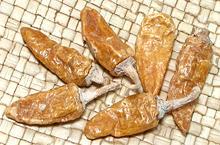
These are small green chilis soaked in yogurt or buttermilk and salt,
then sun baked for nearly a week. Fry them in a little oil and serve as
a condiment. They are used most on the west coast of India. Actually
pretty tasty, hotness from H3 to
H5, depending on what chilis were
used. The photo specimens were Mullaku, about 1-7/8 inches long (48 mm),
so quite hot. Dried green chilis, curd, salt.
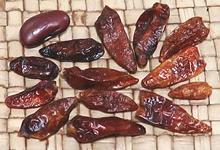 [Bird's Eye Chilis, Bird Chilis; C. frutescens]
[Bird's Eye Chilis, Bird Chilis; C. frutescens]
These are real Bird's Eye Chilis from India. They are small and intensely hot (H9). Most ripen to deep red, but other colors may be seen. These ripen point up. They are hottest just before turning red, losing a little heat when red, and a little more when they are dried.
A number of varieties are available in India, used green, red,
and dried. In North America only dried ones are available, and those
rarely, but Indian expatriates here seem happy enough with the Thai
Chilis grown in California. The largest in the batch the photo specimens
were from was 1.35 inches (3.4 cm) long.
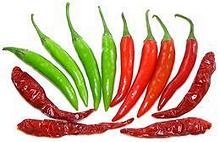 [Bird's Eye Chilis, Bird Chilis; C. annuum]
[Bird's Eye Chilis, Bird Chilis; C. annuum]
These Chilis are becoming the most common hot chilis all over the world,
because they're easier to grow and harvest than real Bird's Eye Chilis.
They aren't as hot, and have a different flavor, but are suitable for
most recipes. Those grown in Tailand are about
H9, but those grown in North
America tend to be more like H8.
Most ripen to deep red, but the ones I grow ripen to bright orange.
Unripe they are green, but if expose to full sun, some are black on the
sun side. They are hottest just before turning red, The photo shows fresh
green and red Thai Chilis grown in California,
and dried red ones from Thailand. The largest was 2.63 inches (6.7 cm)
long (not counting stem) and 0.4 inch (1.0 cm) diameter.
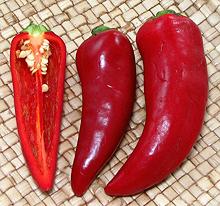 ["Red Jalapeno" (U.S. supermarkets); C. annuum]
["Red Jalapeno" (U.S. supermarkets); C. annuum]
This is not an Indian chili (at least not yet), but it has been
chosen by all ethnicities in Southern California as the medium hot fresh
red chili suitable for their cuisines. Their hotness is about
H4-5. Core and seed them, but
leave in the membranes (where the heat is) if you want heat. With the
membranes carefully removed they are pretty low heat. They have good
flavor, and the walls are quite thick, so they are not dried. For details
see our Fresno Chili page.
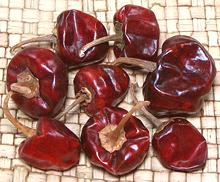
[C. annuum]
Dried. A small almost spherical chili with shiny skin, an orange-red
color and medium heat. It is grown particularly in the Ramnad district
of southern Tamil Nadu, and is used in that state, particularly in
the Chettinad cuisine. The photo specimens, purchased from a large
Indian market in Los Angeles, seemed to vary from around
H6 to
H7. They ranged from 0.7 to
1.25 inches diameter, with most around 1.0 inch (2.5 cm).
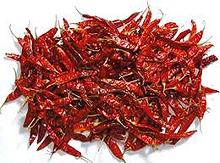 [C. annum mostly var longhum]
[C. annum mostly var longhum]
This is a non-specific term. Guntur, near the central coast of Andhra in southern India (just north of Tamil Nadu on the east coast of India) is a center for chili production, and the source of most exports from India. Notice: Guntur Chilis are illegal to import into the United States or the European Union due to excessive levels of pesticide residue. Photo copyright unknown - widely used by Indian exporters.
Many varieties are grown in Guntur, Here are a few examples:
 This is the fresh green chili produce markets in Los Angeles have been
selling as "Indian Chili". I don't know if such chilis are actually
grown in India - I haven't seen Indian references to long green chilis
that are as mild as these (about
H3). They are up to 4.5 inches (11.5 cm) long, and most are
just shy of 1/2 inch (1.3 cm) in diameter.
This is the fresh green chili produce markets in Los Angeles have been
selling as "Indian Chili". I don't know if such chilis are actually
grown in India - I haven't seen Indian references to long green chilis
that are as mild as these (about
H3). They are up to 4.5 inches (11.5 cm) long, and most are
just shy of 1/2 inch (1.3 cm) in diameter.
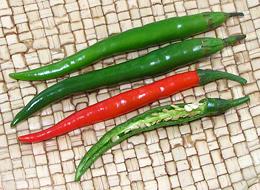 [C. annuum]
[C. annuum]
These started appearing in a Los Angeles produce market in January 2017,
in place of the green chilis pictured above. They are a much more
satisfactory Indian Chili, being quite hot (about
H7). They have the thick taper at
the cap end and the more wrinkly appearance I see in photos of Jawala
chilis in India. The photo specimens were about 4-1/8 inches long and
0.38 inch diameter (10.5 x 1.0 cm).
 [Hontaka, Santaka, Chinese chile pepper; C. annuum]
[Hontaka, Santaka, Chinese chile pepper; C. annuum]
This chili originated in Jalisco, Mexico, but has become well known in
South and Southeast Asia, and China. Indian markets here in
Southern California all have big bags of them, easily identifiable by
having no caps or stems. In North America, it's pretty much the default
dried red chili, available everywhere. It has good flavor and is
moderately hot at low to mid H7.
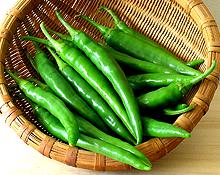 [Hot Finger Chili; C. annuum]
[Hot Finger Chili; C. annuum]
Fresh Green, but sometimes used dried red. This is the
most popular hot green chili in India. They are long (about 5-1/2
inches (14 cm)), very narrow, a little wrinkled, and quite hot (about
H7) - the name means "volcano"
in Hindi. It is grown mainly in Gujarat (situated on the northwest coast
of India). Subst: Serrano (hot end of range) or green de Arbol.
Photo copyright uncertain - used by various chili and seed
vendors in India and elsewhere.
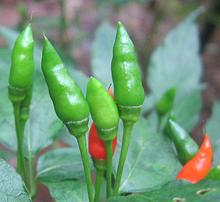
[Bird Chili, Bird's Eye Chili; C. frutescens]
This Bird Chili is grown in Kerala and Tamil Nadu in the far south
of India. One variety has white pods until they ripen through yellow
to bright orange red. Other varieties are green until they ripen to
bright red. It is conical, small, 1.0 x 0.25 inch (2.5 x 0.6 cm) and
very hot (H9). I have found
these sold as "Moru Mulaku Vadagom" or Dried Green Curd Chilis (see
Curd Chilis, above).
Photo by Rojypala contributed to the Public Domain.
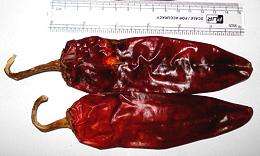 Dried. A very flavorful intensely red chili grown in Kashmir. It is a largish
chili with medium conical shape, a fruity flavor, and little heat. Dried it
is fairly smooth and very dark in color. Kashmir chilis are not much exported
from the region due to scarcity.
Dried. A very flavorful intensely red chili grown in Kashmir. It is a largish
chili with medium conical shape, a fruity flavor, and little heat. Dried it
is fairly smooth and very dark in color. Kashmir chilis are not much exported
from the region due to scarcity.
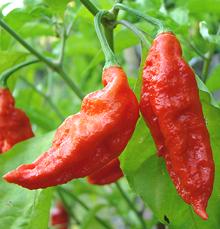 [Bhut Jolokia, Ghost Chili, Bih jolokia, U-morok; C. chinense x
C. frutescens]
[Bhut Jolokia, Ghost Chili, Bih jolokia, U-morok; C. chinense x
C. frutescens]
This chili is grown in the far northeast of India, mainly the states
of Nagaland, Assam and Manipur. It was famous for a while as the hottest
chili known (2007), at about Scoville 1,041,427 (varies widely depending
on where it is grown). It was displaced in 2012 by the "Trinidad Moruga
Scorpion" at about Scoville 1,200,000, which was itself displaced in
2013 by the "Carolina Reaper" from U.S. South Carolina at over Scoville
2,200,000. While commonly red, it is also grown in white, yellow and
purple varieties, and shape can also vary somewhat.
Photo by Thaumaturgist distributed under license Creative
Commons
Attribution-ShareAlike v3.0 Unported.
 [C. annuum]
[C. annuum]
Usually dried. A popular chili in northern India, which will grow in
a wide variety of climates. It is about 4 inches (10 cm) long, 1/2 inch
(1.3 cm) diameter, bright red and wrinkled. Very hot at about
H9.
Photo of Punjab chili from
Kisan Suvidha under Fair Use Doctrine.
 [C. annuum]
[C. annuum]
Dried. A short, broad conical chili of a maroon color and medium heat (H4). It is very popular in Gujarat on the west coast, but is a fine chili for the cuisines of most of India. In Gujarat and Maharshtrian it is used to spice pickles. I have yet to see whole dried Reshampatti chilis here in Southern California, but fine flake is easily available in Indian markets here. It is deep red and quite flavorful. The photo specimens, purchased from a vendor in India, were typical. The largest was 2-7/8 inches (7.3 cm) long and 2 inches (5 cm) wide.
There is a lot of confusion about this chili. Some Internet sites
show it as a long, thin, very hot chili, but the Indian sources from
which I have bought reshampatti chilis, have them as wide and medium
hot.
 [C. annuum]
[C. annuum]
Fresh Green. NOT an Indian Chili (yet), but now popular in Thailand.
They are commonly used in place of Jawalas here in North America. All
the Indian markets here carry them (but so does just about every other
market). They have more flavor than most hot green chilis - but nobody
seems to be complaining. They are fairly hot (about
H6) and can be up to 4.5 inches
(11.5 cm) long and 0.8 inch (2 cm) diameter.
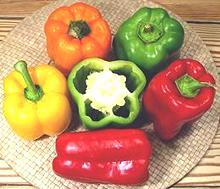 [Capsicum (British); Bell Peppers (North America); C. annuum]
[Capsicum (British); Bell Peppers (North America); C. annuum]
This is the Bell Pepper available everywhere in North America.
They are always available fresh and are only dried for use by industrial
food processors. Box shaped to heart shaped, these are up to 5 inches
(12.7 cm) across here in California, but may be a bit smaller in India.
They feature thick, crisp and flavorful flesh with no heat
(H0), though occasionally one
will be found to have a faint trace of heat.
 "Vathals" are vegetables, dried with a coating of salt or curd and
salt. these chilis claimed only "Chilis, Salt", but the taste suggested
curd was also used. They were about 4-1/2 inches long (114 mm) and quite
hot. The instructions were "Dip fry and serve hot".
"Vathals" are vegetables, dried with a coating of salt or curd and
salt. these chilis claimed only "Chilis, Salt", but the taste suggested
curd was also used. They were about 4-1/2 inches long (114 mm) and quite
hot. The instructions were "Dip fry and serve hot".
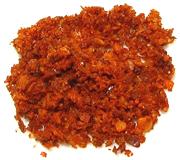
This is NOT an Indian Chili Powder, but Aleppo Extra Hot makes an
excellent substitute for Indian Kashmir powder,
which is much harder to find in North America. Aleppo Mild
(H1) is less hot than Kashmir, and
Aleppo Extra Hot (H2 to H3)
may be slightly hotter. Both are very flavorful.

Hotness H3. Kashmir chili powder
is widely used in Indian cooking, particularly in the relatively softly spiced
meat dishes of the north. It is rarely made from actual Kashmiri chilis, which
are in very short supply, but from other mild, intensely red chilis,
particularly Byadgi / Byadagi. Subst:
Aleppo Extra Hot makes an excellent substitute for Kashmir and is
more available in North America. Aleppo Mild is a little too mild and a lot
sweeter, but some may prefer it, or add a dash of hotter chili. Expatriate
cooks from India often recommend real Hungarian Sweet
Paprika with a dash of Cayenne for hotness.
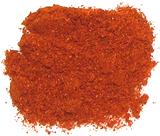 Paprika is much used in Indian cuisine to provide a bright red color
without making the dish too hot, particularly because true Kashmir chilis
are not available. The best to use is genuine Hungarian paprika, which is
sweet (H0), flavorful, brilliant red,
and far superior in taste to American paprika. which is usually ground
from New Mexico chilis. Many expatriate Indian cooks use Paprika with a
dash of Cayenne or other hot pepper to replace Kashmir powder.
Paprika is much used in Indian cuisine to provide a bright red color
without making the dish too hot, particularly because true Kashmir chilis
are not available. The best to use is genuine Hungarian paprika, which is
sweet (H0), flavorful, brilliant red,
and far superior in taste to American paprika. which is usually ground
from New Mexico chilis. Many expatriate Indian cooks use Paprika with a
dash of Cayenne or other hot pepper to replace Kashmir powder.

This chili powder, actually usually a fine flake, is a bit less sweet
and a bit hotter (H4) than Kashmir,
and a good choice for all-around Indian cooking where you don't want
too mild or too hot.

Though whole reshampatti chilis are not much seen in North America, the ground version is very common in Indian markets here. This chili powder, often a fine flake, is a less sweet, significantly hotter (H4) and less red than Kashmir, and a good choice for all-around Indian cooking.
There is confusion about this name. Some sites and vendors list
reshampatti as "very hot" and show long thin red chilis. The photo
specimen I ground myself from the wide reshampatti chilis I purchased
directly from India, so I know exactly what it is.
 This is the hottest, up to H8, of the
chili powders sold in the Indian markets here in Southern California. It
is likely ground from Guntur Chilis and is about as
hot as Cayenne, but with better flavor than most cayennes. Use it for
the cuisines of southern India and on the west coast from Goa on south,
or wherever Cayenne is called for.
This is the hottest, up to H8, of the
chili powders sold in the Indian markets here in Southern California. It
is likely ground from Guntur Chilis and is about as
hot as Cayenne, but with better flavor than most cayennes. Use it for
the cuisines of southern India and on the west coast from Goa on south,
or wherever Cayenne is called for.
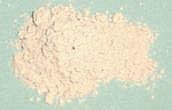
This ground chili powder is used a fair amount in India to spice up
recipes with white sauces (all white feasts were popular with the ruling
class during the Moghul empire period). I'm not sure how it's made but
it's an extremely fine powder and about as hot as Reshampatti (
H4), but it lacks the distinctive
flavor of red chili peppers. Consider it a "hottening agent" only, but
much safer to use than capsaicin extracts.